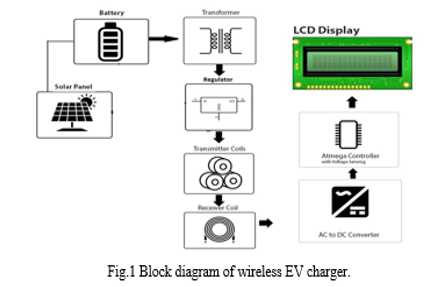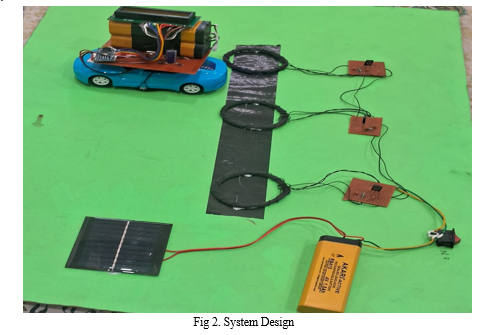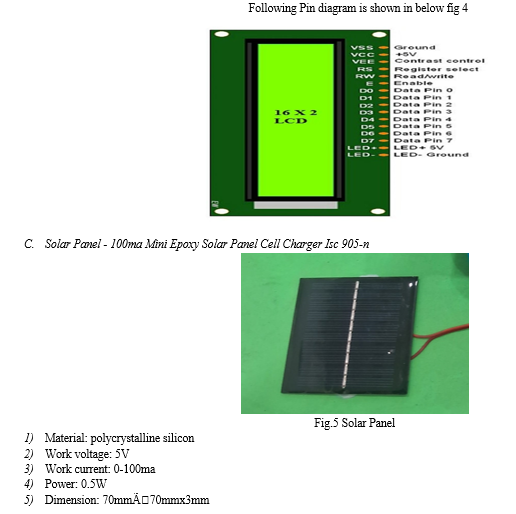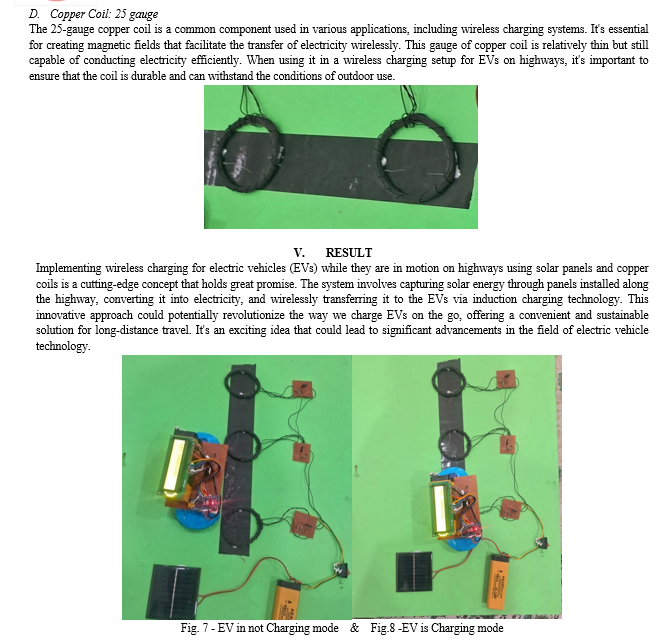Ijraset Journal For Research in Applied Science and Engineering Technology
- Home / Ijraset
- On This Page
- Abstract
- Introduction
- Conclusion
- References
- Copyright
Wireless Charging of Electric Vehicle on Highways in Running Mode by Solar Energy
Authors: Vinam Choudhary, Deepak Saini, Vinay Yadav
DOI Link: https://doi.org/10.22214/ijraset.2024.60771
Certificate: View Certificate
Abstract
The adoption of electric vehicles (EVs) is on the rise globally, driven by the need for sustainable transportation solutions to mitigate climate change and reduce dependence on fossil fuels. However, the infrastructure for charging EVs remains a significant challenge, hindering widespread adoption. In response, innovative approaches such as wireless charging technology, coupled with solar energy, have emerged to address these challenges. This paper presents an overview of wireless charging systems for electric vehicles, integrated with solar energy, aiming to provide a sustainable and convenient solution for EV owners. The integration of wireless charging and solar energy offers numerous benefits, including convenience, efficiency, and environmental sustainability. By eliminating the need for physical connections and harnessing the power of the sun, electric vehicles can be charged seamlessly and sustainably, reducing reliance on the grid and lowering carbon emissions. This paper discusses the principles behind wireless charging technology, the design considerations for integrating solar energy, and the potential impact on the future of sustainable transportation. Additionally, it addresses the challenges and opportunities associated with this innovative approach, highlighting the need for further research and development to realize its full potential. Overall, the convergence of wireless charging technology with solar energy represents a promising solution to the challenges facing the widespread adoption of electric vehicles, contributing to a cleaner and greener transportation ecosystem.
Introduction
I. INTRODUCTION
In recent years, the surge in electric vehicle (EV) adoption has been remarkable, driven by concerns over environmental sustainability and the need to reduce carbon emissions. However, one of the critical challenges facing the widespread adoption of electric vehicles is the infrastructure for charging. Traditional charging stations often require physical connections, which can be inconvenient and limit the flexibility of EV usage. To address this issue, innovative solutions such as wireless charging have emerged, offering convenience and efficiency. Wireless charging technology eliminates the need for cumbersome cables and connectors, providing a seamless and user-friendly experience for EV owners. By harnessing the power of electromagnetic fields, wireless charging systems transfer energy from a charging pad to the vehicle's battery without direct contact. This technology not only simplifies the charging process but also reduces wear and tear on charging connectors, enhancing overall reliability.
Moreover, integrating solar energy into wireless charging systems presents a compelling solution to further enhance sustainability and reduce dependence on the grid. Solar panels, often installed on canopies or rooftops, capture sunlight and convert it into electricity. This renewable energy source can then be utilized to power wireless charging stations, making them more environmentally friendly and cost-effective in the long run. The combination of wireless charging and solar energy holds immense potential for revolutionizing the EV charging infrastructure. By leveraging the abundant and renewable power of the sun, electric vehicles can be charged efficiently and sustainably, contributing to a greener transportation ecosystem. Additionally, the decentralized nature of solar-powered wireless charging stations offers greater flexibility in deployment, enabling EV owners to charge their vehicles conveniently at various locations, including homes, workplaces, and public parking lots.
II. LITERATURE REVIEW
Literature Review on Wireless Charging of Electric Vehicles with Solar Energy Integration
- "Wireless Charging Technologies for Electric Vehicles: A Review"
Authors: Prakash Kumar U., Ravi S., Suresh L., Arun Kumar M.
This review paper provides a comprehensive overview of various wireless charging technologies for electric vehicles, including inductive charging, magnetic resonance coupling, and capacitive coupling. It discusses the advantages and limitations of each technology and explores their potential applications in different scenarios. Furthermore, the paper highlights the integration of solar energy into wireless charging systems to enhance sustainability and reduce reliance on the grid.
2. "Solar-Powered Wireless Charging Systems for Electric Vehicles: A Review"
Authors: Liang Hu, Xinglin Li, Zhongpeng Zhu, Yulong Zhou
Focusing specifically on the integration of solar energy into wireless charging systems for electric vehicles, this review paper examines the latest developments in the field. It discusses the design considerations, efficiency challenges, and potential solutions for creating solar-powered charging stations. The paper also evaluates the economic viability and environmental benefits of solar-powered wireless charging infrastructure.
3. "Wireless Power Transfer Systems for Electric Vehicle Applications: A Review of Inductive Charging"
Authors: Bruno Gyselinckx, Chris Mi
This review paper provides a detailed analysis of inductive charging technology for electric vehicle applications. It discusses the principles of inductive power transfer, system design considerations, and efficiency optimization techniques. Additionally, the paper explores the integration of renewable energy sources, such as solar power, to enhance the sustainability of wireless charging infrastructure.
4. "Integration of Solar Energy and Wireless Charging for Electric Vehicles: Opportunities and Challenges"
Authors: Ming-Jun Tsai, Chih-Hung Chang, Yi-Ju Yang, Ching-Yen Chung
Focusing on the integration of solar energy and wireless charging technology, this paper examines the opportunities and challenges associated with this approach. It discusses the technical feasibility, economic viability, and environmental impact of deploying solar-powered wireless charging stations for electric vehicles. The paper also identifies key research areas for future development and deployment of such systems.
5. "Review on the Application of Solar Energy in Wireless Power Transfer for Electric Vehicle Charging"
Authors: Yi Cao, Wenjuan Xie, Huijun Gao, Shuai Dong, Bingzhao Gao
This review paper provides a comprehensive analysis of the application of solar energy in wireless power transfer systems for electric vehicle charging. It discusses the latest advancements in solar panel technology, power electronics, and control algorithms to improve the efficiency and reliability of solar-powered charging stations. Additionally, the paper evaluates the potential impact of integrating solar energy into wireless charging infrastructure on energy consumption and environmental sustainability.
These literature reviews collectively provide valuable insights into the current state of research and development in wireless charging of electric vehicles with the integration of solar energy. They offer a thorough analysis of the technologies involved, the challenges faced, and the opportunities for future advancements in this rapidly evolving field

III. METHODOLOGY
Methodology for Wireless Charging of Electric Vehicles with Solar Energy Integration:
A. System Design and Configuration
- Define the specifications and requirements of the wireless charging system, including power output, efficiency targets, and compatibility with electric vehicles.
- Determine the optimal configuration of the solar panels, taking into account factors such as orientation, tilt angle, and shading
- Design the layout of the charging infrastructure, considering factors such as parking space availability, accessibility, and aesthetics.

B. Selection of Components
The components used for wireless charging of electric vehicles (EVs) while moving on highways using solar energy.
- *Charging Coils*: These coils are embedded in the road surface and interact with coils on the EV to transfer power wirelessly. They create a magnetic field that allows for efficient power transfer.
- *Coils on EVs*: EVs are equipped with coils that receive the power wirelessly from the charging coils embedded in the road. These coils are essential for capturing the transferred energy.
- *Solar Panels*: Solar panels are installed along the highways to capture sunlight and convert it into electricity. This solar energy is then used to power the charging coils embedded in the road, enabling the wireless charging process.
- *Power Management System*: This system regulates the power flow between the charging coils on the road and the coils on the EVs. It ensures efficient and safe charging of the vehicles while they are in motion.
By combining these components effectively, the wireless charging technology for EVs on highways using solar energy can provide a sustainable and convenient way to charge electric vehicles on the go.
a. Integration of Wireless Charging and Solar Energy
- Develop the interface between the wireless charging system and the solar panels to enable seamless integration.
- Implement power management algorithms to optimize the utilization of solar energy for charging electric vehicles while ensuring grid compatibility and stability.
- Integrate smart charging functionalities to enable communication between the charging infrastructure, electric vehicles, and the grid for load management and scheduling.
b. Efficiency Optimization
- Conduct simulations and modeling studies to optimize the efficiency of the wireless charging system under varying environmental conditions, such as sunlight intensity and temperature.
- Implement maximum power point tracking (MPPT) algorithms to maximize the power output from the solar panels and improve overall system efficiency.
- Explore advanced control strategies, such as impedance matching and resonance tuning, to enhance wireless power transfer efficiency and minimize energy losses.
c. Safety and Regulatory Compliance
- Ensure compliance with relevant safety standards and regulations for electric vehicle charging systems, including electromagnetic compatibility (EMC) and electrical safety requirements.
- Implement safety features such as overcurrent protection, short-circuit protection, and ground fault detection to prevent accidents and ensure user safety.
Perform thorough testing and validation of the wireless charging system to verify its performance, reliability, and compliance with regulatory requirements
d. Deployment and Monitoring
- Install the wireless charging infrastructure at suitable locations, such as parking lots, residential complexes, and public charging stations.
- Implement remote monitoring and control capabilities to enable real-time monitoring of system performance, energy generation, and charging sessions.
- Provide user-friendly interfaces, such as mobile apps or web portals, to allow EV owners to access charging services, monitor charging status, and track energy usage.
IV. COMPONENTS
A. Arduino-Nano
The compact and adaptable Arduino Nano development board is based on the well-liked ATmega328 microprocessor. It performs similarly to the Arduino UNO but has a more compact design. The Nano may be readily incorporated into a variety of circuits and applications and is intended to be used for small-scale projects.
The Arduino Nano board features a USB interface for easy programming and communication, 14 digital input/output pins, 8 analog input pins, and 6 pulse-width modulation (PWM) pins. It also has a 16 MHz quartz crystal oscillator, a mini USB port, and a DC power jack.
TheboardiscompatiblewiththeArduinoIDE,whichallowsuserstoeasilywriteanduploadcodetotheboard.
The Arduino Nano is perfect for applications that need mobility or have a small footprint due to its small size. Both novice and expert producers choose it because of its affordable price and user-friendly interface.

B. LED Display
16*2 LCD is named because ; it has16Columnsand2Rows
- Pin1(Ground/Source Pin):This is a GND pin of display, used to connect GND terminal to the microcontroller unit or power source.
- Pin2(VCC/Source Pin):This is the voltage supply pin of the display ,used to connect the supply pin of power source.
- Pin3(V0/VEE/Control Pin) : This Pin regulates the difference of the display, used to connect a changeable POT that can supply 0 to 5V.
- Pin4 (Register Select/Control Pin) : This pin toggles among command or data register, used to connect a microcontroller unit pin and obtain either 0 or 1(0 = data mode, and 1 = command mode).
- Pin5 (Read/Write/Control Pin) : This pin toggles the display among the read or writes operation, and it is connected to a microcontroller unit pin to get either 0 or 1 (0 = Write Operation, and 1 = Read Operation).
- Pin 6 (Enable/Control Pin) : This pin should be held high to execute Read/Write process, and it is connected to the microcontroller unit and constantly held high.
- Pin 7-14 (Data Pins) : These Pins are used to send data to the display. These pins are connected in two-wire modes like4-wire mode and 8-wire mode. In 4 wire mode, only four pins are connected to the microcontroller unit like 0 to 3, whereas in 8 wire mode , 8 pins are connected to microcontroller unit like 0 to 7.


Conclusion
The convergence of wireless charging technology and solar energy holds immense promise for revolutionizing the electric vehicle (EV) charging infrastructure, paving the way for a more sustainable and efficient transportation ecosystem. Through this integration, electric vehicle owners can benefit from the convenience of wireless charging while harnessing the abundant and renewable power of the sun to power their vehicles. The deployment of wireless charging systems powered by solar energy offers several key advantages. First and foremost, it eliminates the need for physical connections, providing a seamless and user-friendly charging experience for EV owners. By removing the hassle of plugging and unplugging cables, wireless charging systems enhance convenience and promote greater adoption of electric vehicles. Furthermore, the utilization of solar energy for charging electric vehicles reduces reliance on the grid and helps mitigate the environmental impact of transportation. Solar-powered charging stations generate clean and renewable electricity, reducing carbon emissions and contributing to overall sustainability efforts. Moreover, the decentralized nature of solar-powered charging infrastructure allows for greater flexibility in deployment, enabling EV owners to charge their vehicles conveniently at various locations, including homes, workplaces, and public parking lots. However, several challenges must be addressed to realize the full potential of wireless charging systems powered by solar energy. These include optimizing efficiency under varying environmental conditions, ensuring regulatory compliance and safety standards, and managing the integration of renewable energy sources with existing grid infrastructure. In conclusion, the integration of wireless charging technology with solar energy offers a promising solution to the challenges facing the widespread adoption of electric vehicles. By providing convenient, efficient, and environmentally friendly charging solutions, this approach has the potential to accelerate the transition to sustainable transportation and contribute to a cleaner and greener future. Continued research, innovation, and collaboration are essential to overcoming the remaining hurdles and unlocking the full benefits of solar-powered wireless charging for electric vehicles.
References
[1] Kurs, A. Karalis, R. Mo?att, J. D. Joannopoulos, P. Fisher,M. Solja?i?, Wireless power transfer via strongly coupled magneticresonances, Science 317 (5834) (2007) 83–86. doi:10.1126/science.1143254. [2] S. Chhawchharia, S. K. Sahoo, M. Balamurugan, S. Sukchai,F. Yanine, Investigation of wireless power transfer applications witha focus on renewable energy, Renewable and Sustainable Energy Reviews 91 (2018) 888–902. doi:https://doi.org/10.1016/j.rser.2018.04.101. [3] S. D. Barman, A. W. Reza, N. Kumar, M. E. Karim, A. B. Munir,Wireless powering by magnetic resonant coupling: Recent trends in wireless power transfer system and its applications, Renewable and Sustainable Energy Reviews 51 (2015) 1525–1552. doi:https://doi.org/10.1016/j.rser.2015.07.031. [4] X. Zhang, Z. Yuan, Q. Yang, Y. Li, J. Zhu, Y. Li, Coil design ande?ciency analysis for dynamic wireless charging system for electricvehicles, IEEE Transactions on Magnetics 52 (7) (2016) 1–4. doi:10.1109/TMAG.2016.2529682. [5] A. N. Azad, A. Echols, V. A. Kulyukin, R. Zane, Z. Pantic,Analysis, optimization, and demonstration of a vehicular detectionsystem intended for dynamic wireless charging applications, IEEETransactions on Transportation Electri?cation 5 (1) (2019) 147–161.doi:10.1109/TTE.2018.2870339. [6] M. Longo, D. Zaninelli, G. Cipriani, V. Di Dio, R. Miceli, Economic analysis on the use of wired and wireless recharging systems, in:2017 IEEE International Conference on Environment and ElectricalEngineering and 2017 IEEE Industrial and Commercial Power Systems Europe (EEEIC / I CPS Europe), 2017, pp. 1–6. doi:10.1109/EEEIC.2017.7977704. [7] F. M. Eltoumi, M. Becherif, A. Djerdir, H. Ramadan, The keissues of electric vehicle charging via hybrid power sources:Techno-economic viability, analysis, and recommendations,Renewable and Sustainable Energy Reviews 138 (2021) 110534.doi:https://doi.org/10.1016/j.rser.2020.110534. [8] D. M. Vilathgamuwa, J. P. K. Sampath, Wireless Power Transfer(WPT) for Electric Vehicles (EVs)—Present and Future Trends,Springer Singapore, Singapore, 2015, pp. 33–60. doi:10.1007/978-981- 287-299- 9_2. [9] A. Vallera, P. Nunes, M. Brito, Why we need battery swapping technology, Energy Policy 157 (2021) 112481. doi:https://doi. org/10.1016/j.enpol.2021.112481. [10] F. Tuchnitz, N. Ebell, J. Schlund, M. Pruckner, Development and evaluation of a smart charging strategy for an electric vehicle ?eet based on reinforcement learning, Applied Energy 285 (2021) 116382. doi:https://doi.org/10.1016/j.apenergy.2020.116382. [11] M. Abdolmaleki, N. Masoud, Y. Yin, Vehicle-to-vehicle wireless power transfer: Paving the way toward an electri?ed transportationsystem, Transportation Research Part C: Emerging Technologies103 (2019) 261–280. doi:https://doi.org/10.1016/j.trc.2019.04.008. [12] S. R. Khutwad, S. Gaur, Wireless charging system for electric vehicle, in: 2016 International Conference on Signal Processing,Communication, Power and Embedded System (SCOPES), 2016,pp. 441–445. doi:10.1109/SCOPES.2016.7955869. [13] R. J. Flores, B. P. Sha?er, J. Brouwer, Electricity costs for an electric vehicle fueling station with level 3 charging, Applied Energy 169(2016) 813–830. doi:https://doi.org/10.1016/j.apenergy.2016.02.071. [14] X. Mou, R. Zhao, D. T. Gladwin, Vehicle-to-vehicle charging system fundamental and design comparison, in: 2019 IEEE InternationalConference on Industrial Technology (ICIT), 2019, pp. 1628–1633. doi:10.1109/ICIT.2019.8755057. [15] M. Etemadrezaei, 22 - wireless power transfer, in: M. H. Rashid (Ed.), Power Electronics Handbook (Fourth Edition), fourth edition Edition, Butterworth-Heinemann, 2018, pp. 711–722. doi:https://doi.org/10.1016/B978-0- 12-811407- 0.00024- 6.
Copyright
Copyright © 2024 Vinam Choudhary, Deepak Saini, Vinay Yadav. This is an open access article distributed under the Creative Commons Attribution License, which permits unrestricted use, distribution, and reproduction in any medium, provided the original work is properly cited.

Download Paper
Paper Id : IJRASET60771
Publish Date : 2024-04-22
ISSN : 2321-9653
Publisher Name : IJRASET
DOI Link : Click Here
 Submit Paper Online
Submit Paper Online

